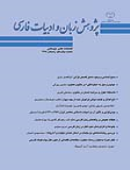تحلیل سیر بازتاب مضامین و روایتهای اسطورهای ایرانی در رمانهای فارسی (از 28 مرداد 1332 تا 1387)
محورهای موضوعی : پژوهشهای ادبیات کلاسیک ایران
سعید بزرگ بیگدلی
1
![]() ,
حسن شاهیپور
2
,
دکتر سید علی قاسمزاده
3
,
حسن شاهیپور
2
,
دکتر سید علی قاسمزاده
3
1 -
2 -
3 - ادبیات و علوم انسانی
کلید واژه: بنمایه روایت اسطورهای نقد اسطورهای رمان فارسی,
چکیده مقاله :
بروز و ظهور اساطیر در رمانهای فارسی کوششی است جریانساز که رماننويسان برای دستیابی به دو انگیزه اساسی: یکی ارائة تفسیری موافق با دریافت خویش از اوضاع دنیای پیرامون خویش و دیگری بازتاب ارزشهای زیباشناسانه و پرجذبه، از خود نشان دادهاند. پژوهش حاضر، با روش توصیفیـ تحلیلی و مرور بر اسناد ادبی معاصر، در پی تحلیل چگونگی و سیر انعکاس، دلایل بازسازی و بازپردازی مضامین و روایتهای اسطورهای ملی و مذهبی در حوزة رمانهای فارسی است. بنابر نتایج این پژوهش، بیشترین رویکرد رماننویسان به بازسازی و بازآفرینی اسطورهها به دهههای چهل و پنجاه برمیگردد؛ یکی از دلایل اصلی ظهور اين رويكرد، شکست نهضت مردمی ملّيشدن صنعت نفت در اثر کودتای 28 مرداد است. اما پس از انقلاب اسلامي، بیشترین بازآفرینی اسطورهها در رمان، دهههای هفتاد و هشتاد دیده میشود که به دلایلی عمدتاً متفاوت از دلایل پیش از انقلاب چون پیروی گستردة نویسندگان از جریانهای مدرنیستی و پسامدرنیسم، تمایل زیباشناختی، تقویت و احیای جنبههای ملی، بازگشت به سرچشمههای بومی به جای تقلید از غرب است.
The emergence of mythology in the contemporary Persian novels, as the dominant literary discourse, is an epoch making movement. Based upon their vision and socio- political situation, many of the contemporary authors have used mythology in order to achieve two main goals: one, to present an interpretation of the world around, and the other, to enhance the esthetic and attractive values which they are to present in their works. According to the findings of the research, novelists within the 1340’s and 1350’s showed most concern toward restructuring and reproducing myth ever. A main reason was the authors’ nostalgias caused by the events such as the defeat of folk movement and the coup of Mordad 28th which mad long and deep impression on them. The most tendencies to myths in post-revolution period can be seen in 1370’s and 1380’s. However, the authors’ motivations differ from those of the pre-revolution period. A vast number of writers follow modernist and postmodernist movements and aesthetical tastes; some try to strengthen and revive national features, turn back to their traditional origins rather than pure imitating the West. The present research seeks to study and analyze how the mythological theme and narratives have been reflected, reproduced in the contemporary Iranian novels from mordad 28th 1332 to 1387.


